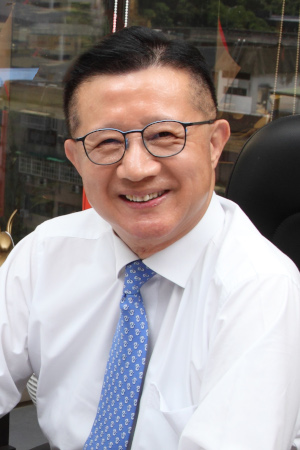Surging Energy Demand Fuels Need for Specialized Transportation
_1.jpg)
By Damon Evans
Taiwan has become GE Vernova’s fastest-growing market in Asia, a signal of the island’s booming project sector. What does this mean for specialized transport services? Executives from AAL Shipping and EZ LINK weigh in on the growing opportunities.
From Issue 4, 2025 of Breakbulk Magazine
(5-minute read)
Taiwan is actively advancing its energy sector, focusing on expanding offshore wind power and liquefied natural gas (LNG) infrastructure to boost energy security and cut carbon emissions after phasing out its aging nuclear fleet.
Companies equipped to handle the complexities of transporting large-scale energy components are expected to find ample opportunity in Taiwan’s evolving power market. “Taiwan is a market full of promise, especially for the breakbulk and project cargo sector,” Felix Schoeller, director at AAL Shipping, told Breakbulk.
“According to data from Taiwan’s Ministry of Finance, the first four months of 2025 saw robust growth: exports surged by 20.6% year-on-year, and imports grew by 20.4%. While much of the export strength is being driven by the AI boom, we’re seeing solid gains in breakbulk-relevant industries as well: base metals and machinery exports rose by 7.6% and 7.1%, respectively,” he said.
A surge in data centers, and the increasing demand for power as a result, is fueling demand for power infrastructure, Schoeller noted. “That means more transformers, heavy electrical equipment and breakbulk exports from Taiwan to the U.S. and Europe in the medium term. On imports, Taiwan’s ambitious offshore wind program will increase demand for project cargo movements from Europe to Taiwan.”
AAL said its new Super B-Class vessels — designed with input from energy sector clients to improve stowage flexibility and crane capacity — along with its Asia-Europe Express Service, are positioned to support ongoing energy and industrial projects in Taiwan.
Abandoning Nuclear Power?
In May, Taiwan exited nuclear power with the retirement of its last legacy reactor. Premier Cho Jung-tai has said renewable energy and gas-fired capacity will increase to meet rising electricity demand driven by new investments in artificial intelligence, semiconductors, data centers and other high-tech sectors through 2032.
Taiwan is home to a world-leading chip industry, including Taiwan Semiconductor Manufacturing Co. (TSMC), the world’s largest chipmaker.
While Taiwan remains the company’s primary manufacturing base, TSMC is also investing heavily in the U.S. Its planned investment in U.S. chip fabs totals US$165 billion, making it the largest single foreign direct investment in U.S. history. The centerpiece is a sprawling hub in Phoenix, Arizona, where the company began volume production at its first fab in late 2024. The company has plans for up to six fabs, two advanced packaging sites and a major R&D center.
In Taiwan, Kevin Liu, vice president of corporate strategy at local cable manufacturing conglomerate Walsin Lihwa Corporation, told Breakbulk that nuclear power could eventually make a comeback, with ongoing debate around next-generation reactors and small modular reactors (SMRs) expected to accelerate as energy security becomes increasingly important.
Natural resource-poor Taiwan, which has traditionally relied on coal to generate electricity, has set a target for at least 60% of its power generation to come from renewable sources by 2050, the year it aims to reach net-zero emissions.
The Rise of Renewables and Gas
According to Taiwan’s Ministry of Economic Affairs Energy Administration, LNG-fueled power generation is expected to rise from 42.4% in 2024 to 50% by 2030 and 54% in 2035. Renewables are projected to grow from an 11.6% share in 2024 to 30% in 2030 and 36% by 2035, while coal-fired power is expected to fall from 39.3% in 2024 to 20% in 2030 and just 9% by 2035.
 “Taiwan’s aggressive push towards renewable energy, particularly offshore wind, coupled with infrastructure projects like LNG terminals, positions the breakbulk shipping industry for significant growth,” said Jimmy Yang, general manager in Taiwan of freight forwarding and logistics company EZ LINK CORP, a member of The Heavy Lift Group.
“Taiwan’s aggressive push towards renewable energy, particularly offshore wind, coupled with infrastructure projects like LNG terminals, positions the breakbulk shipping industry for significant growth,” said Jimmy Yang, general manager in Taiwan of freight forwarding and logistics company EZ LINK CORP, a member of The Heavy Lift Group.
“The transportation of large-scale energy components will continue to be a critical aspect of these developments, offering ample opportunities for logistics providers specializing in breakbulk and project cargo,” he added.
Taiwan aims to add 10 GW of offshore wind power between 2026 and 2035, as it seeks to have at least 15 GW installed capacity by 2035, positioning itself as a leading market in Asia Pacific. “This expansion necessitates the transportation of large and heavy components, such as turbine blades, tower sections and substations, that are ideally suited for breakbulk shipping methods,” said Yang.
The development of specialized vessels and infrastructure further underscores this opportunity. For instance, the Green Jade, a heavy-lift installation vessel built in Taiwan by CSBC Corporation, has been instrumental in projects, such as the Hai Long Offshore Wind development, showcasing the nation’s growing capabilities in handling complex offshore installations, noted Yang.
Walsin’s Liu expects a lot of construction activity to take place for the offshore wind projects over the next two years, with potentially more developments being approved.
Offshore Opportunities
Highlighting the pace of offshore activity, the AAL Nanjing recently delivered a 370-tonne cable carousel from Jebel Ali, Dubai, to Taichung, Taiwan, which will be used to spool 3,000 tonnes of undersea power cables for an offshore wind farm. The Nanjing’s port-mounted heavy lift cranes were rigged at three points to a 22.5-meter lifting beam to load and discharge the cargo.
More projects are on the horizon. Clean energy fund manager Copenhagen Infrastructure Partners (CIP) said in March that it had reached financial close on its 495-MW Fengmiao I wind project, off the coast of Taichung.
“Fengmiao I is the first offshore wind project in Taiwan to be supported by a portfolio of corporate offtakers and will deliver much-needed clean energy to large energy users in Taiwan,” CIP said in a statement.
Construction for the project, which started in March and will feature 33 Vestas 15-MW turbines, is set to be completed by the end of 2027. A consortium comprising Semco Maritime and PTSC Mechanical & Construction has been awarded the engineering, procurement and construction contract. The transportation and installation of foundations are being handled by CSBC-DEME Wind Engineering (CDWE), utilizing the Green Jade vessel.
Other potential projects include Synera Renewable Energy’s 800 MW Formosa 6, Shinfox’s 700 MW Youde, and CIP’s 600 MW Fengmiao 2.
Taiwan, already a leader in fixed-bottom offshore wind energy in the Asia-Pacific region, is also setting its sights on floating wind technology to harness wind resources in deep waters unsuitable for traditional foundations. This innovation will require specialized logistics solutions, offering new opportunities for project cargo service providers.
Floating developers were hoping the government would publish feed-in tariffs this year to encourage investment. However, the much-needed incentives do not appear to be coming yet, stalling momentum for now.
More LNG After Nuclear Exit
.jpg) Taiwan’s energy sector growth is not limited to offshore wind. Gas and LNG are becoming a crucial part of its energy mix as the island phases out nuclear power. There is a lot of activity in the LNG sector, as Taiwan is dependent on LNG to address the gap left behind by the nuclear retirement, which will not be plugged by renewables anytime soon, said Liu.
Taiwan’s energy sector growth is not limited to offshore wind. Gas and LNG are becoming a crucial part of its energy mix as the island phases out nuclear power. There is a lot of activity in the LNG sector, as Taiwan is dependent on LNG to address the gap left behind by the nuclear retirement, which will not be plugged by renewables anytime soon, said Liu.
“There’s an urgent and immediate need for LNG in Taiwan. One thing is certain, Taiwan requires a lot more gas in the next five years, and energy security is becoming more important than net zero.”
GE Vernova, one of the world’s biggest gas turbine makers, noted that Taiwan is its fastest-growing Asian market. The company sees plenty of opportunities as electricity demand expands to fuel the growing chipmaking business. Taiwan also remains open to using new nuclear technology, and GE Vernova reported it could end up selling small modular nuclear reactors to the nation in the long run, if there is political consensus on safety and good waste management.
Various LNG projects are proposed and under construction, said EZ LINK’s Yang. “Projects like the Guantang LNG terminal, expected to be completed this year, also require substantial breakbulk logistics support for transporting oversized equipment and materials.”
Taiwan Power Company plans to build an LNG receiving terminal in Keelung. The project includes converting the 2-GW oil-fired Xiehe power plant – currently the only fully oil-fired power plant in Taiwan – into a gas-fired facility.
Mai-Liao Power Corporation has proposed to build a 1.8- to 2.4-GW gasfired combined cycle power plant with an LNG terminal to replace a coal-fired power plant at the Formosa Plastics petrochemical complex in Mailiao.
Last December, Taiwan’s environment ministry approved state-owned CPC’s plan to construct an LNG receiving terminal, called Yung-An LNG, in the port city of Kaohsiung, in the south of Taiwan.
In March, CPC awarded an EPC contract to compatriot CTCI and a unit of Japan’s IHI to build four aboveground, double-domed cryogenic LNG tanks, each with 180,000 cubic meters storage capacity, at the planned import terminal. The project is expected to be completed by late 2030.
As Taiwan’s energy transition gains pace, and offshore wind and LNG developments progress, a steady pipeline of project cargo activity awaits.
Breakbulk Asia will be launching in Singapore at Marina Bay Sands from 18-19 November 2026.
Top photo: Taiwan-flagged Green Jade carries out installation work at Hai Long. Credit: Hai Long Offshore Wind
Second: Jimmy Yang, general manager in Taiwan of EZ LINK. Credit: EZ LINK
Third: AAL Nanjing heavy-lift cranes handle a 370-tonne cable carousel destined for Taichung, Taiwan. Credit: AAL Shipping
